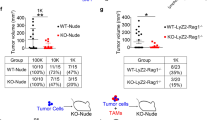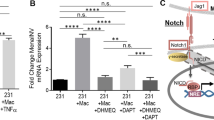Abstract
The phenotypic diversity of tumor-associated macrophages (TAMs) increases with tumor development. One of the hallmarks of malignancy is the polarization of TAMs from a pro-immune (M1) phenotype to an immunosuppressive (M2) phenotype. However, the molecular basis of this process is still unclear. Endostatin is a powerful inhibitor of angiogenesis capable of suppressing tumor growth and metastasis. Here, we demonstrate that endostatin induces RAW264.7 cell polarization toward the M1 phenotype in vitro. Endostatin has no effect on TAM numbers in vivo, but results in an increased proportion of F4/80+Nos2+ cells and a decreased proportion of F4/80+CD206+ cells. Overexpression of endostatin in RAW264.7 cells resulted in a decrease in the phosphorylation of STAT3, an increase in expression of vascular endothelial growth factor A and placental growth factor, and an increase in the phosphorylation of STAT1, IκBα and p65 proteins compared with controls. These results indicate that endostatin regulates macrophage polarization, promoting the M1 phenotype by targeting NF-κB and STAT signaling.






Similar content being viewed by others
Abbreviations
- APC:
-
Allophycocyanin
- Arg1:
-
Arginase-1
- BMDM:
-
Bone marrow-derived macrophage
- CD206:
-
Mannose receptor 1
- cDNA:
-
Complementary DNA
- CFC:
-
Colony-forming cell
- COX2:
-
Cyclooxygenase 2
- DMSO:
-
Dimethylsulfoxide
- ELISA:
-
Enzyme-linked immunosorbent assay
- FBS:
-
Fetal bovine serum
- FCM:
-
Flow cytometry
- FITC:
-
Fluorescein isothiocyanate
- IHC:
-
Immunohistochemistry
- IL-6:
-
Interleukin 6
- IL-10:
-
Interleukin 10
- IL-12p40:
-
Interleukin 12p40
- M1:
-
Classical activation macrophage
- M2:
-
Alternative activation macrophage
- MMP:
-
Matrix metalloproteinase
- MTT:
-
3-(4,5-Dimethylthiazol-2-yl)-2,5-dimethyltetrazolium bromide
- NF-κB:
-
Nuclear factor κB
- NOS2:
-
Inducible nitric oxide synthase
- PBS:
-
Phosphate-buffered saline
- PE:
-
Phycoerythrin
- PI:
-
Propidium iodide
- PIGF:
-
Placenta growth factor
- qRT-PCR:
-
Quantitative real-time reverse transcription polymerase chain reaction
- SEM:
-
Scanning electron microscopy
- STAT:
-
Signal transducer and activator of transcriptions
- TAMs:
-
Tumor-associated macrophages
- VEGF:
-
Vascular endothelial growth factor
References
Gordon S, Taylor PR (2005) Monocyte and macrophage heterogeneity. Nat Rev Immunol 5(12):953–964. doi:10.1038/nri1733
Mosser DM, Edwards JP (2008) Exploring the full spectrum of macrophage activation. Nat Rev Immunol 8(12):958–969. doi:10.1038/nri2448
Gordon S (2003) Alternative activation of macrophages. Nat Rev Immunol 3(1):23–35. doi:10.1038/nri978
Mantovani A, Allavena P, Sica A, Balkwill F (2008) Cancer-related inflammation. Nature 454(7203):436–444. doi:10.1038/nature07205
Mantovani A, Sica A, Allavena P, Garlanda C, Locati M (2009) Tumor-associated macrophages and the related myeloid-derived suppressor cells as a paradigm of the diversity of macrophage activation. Hum Immunol 70(5):325–330. doi:10.1016/j.humimm.2009.02.008
Sonda N, Chioda M, Zilio S, Simonato F, Bronte V (2011) Transcription factors in myeloid-derived suppressor cell recruitment and function. Curr Opin Immunol 23(2):279–285. doi:10.1016/j.coi.2010.12.006
Murdoch C, Lewis CE (2005) Macrophage migration and gene expression in response to tumor hypoxia. Int J Cancer 117(5):701–708. doi:10.1002/ijc.21422
Lewis CE, Pollard JW (2006) Distinct role of macrophages in different tumor microenvironments. Cancer Res 66(2):605–612. doi:10.1158/0008-5472.CAN-05-4005
Sica A, Larghi P, Mancino A, Rubino L, Porta C, Totaro MG, Rimoldi M, Biswas SK, Allavena P, Mantovani A (2008) Macrophage polarization in tumour progression. Semin Cancer Biol 18(5):349–355. doi:10.1016/j.semcancer.2008.03.004
Tai SK, Chang HC, Lan KL, Lee CT, Yang CY, Chen NJ, Chou TY, Tarng DC, Hsieh SL (2012) Decoy receptor 3 enhances tumor progression via induction of tumor-associated macrophages. J Immunol 188(5):2464–2471. doi:10.4049/jimmunol.1101101
O’Reilly MS, Boehm T, Shing Y, Fukai N, Vasios G, Lane WS, Flynn E, Birkhead JR, Olsen BR, Folkman J (1997) Endostatin: an endogenous inhibitor of angiogenesis and tumor growth. Cell 88(2):277–285. doi:10.1016/S0092-8674(00)81848-6
Hamano Y, Okude T, Shirai R, Sato I, Kimura R, Oqawa M, Ueda Y, Yokosuka O, Kalluri R, Uesa S (2010) Lack of collagen XVIII/endostatin exacerbates immune-mediated glomerulonephritis. J Am Soc Nephrol 21(9):1445–1455. doi:10.1681/ASN.2009050492
Rocha FG, Chaves KC, Chammas R, Peron JP, Rizzo LV, Schor N, Bellini MH (2010) Endostatin gene therapy enhances the efficacy of IL-2 in suppressing metastatic renal cell carcinoma in mice. Cancer Immunol Immunother 59(9):1357–1365. doi:10.1007/s00262-010-0865-6
Jia H, Li Y, Zhao T, Li X, Hu J, Yin D, Guo B, Kopecko DJ, Zhao X, Zhang L, Xu DQ (2012) Antitumor effects of Stat3-siRNA and endostatin combined therapies, delivered by attenuated Salmonella, on orthotopically implanted hepatocarcinoma. Cancer Immunol Immunother 61(11):1977–1987. doi:10.1007/s00262-012-1256-y
Coutinho EL, Andrade LN, Chammas R, Morganti L, Schor N, Bellini MH (2007) Anti-tumor effect of endostatin mediated by retroviral gene transfer in mice bearing renal cell carcinoma. FASEB J 21(12):3153–3161. doi:10.1096/fj.07-8412com
Ying W, Cheruku PS, Bazer FW, Safe SH, Zhou B (2013) Investigation of macrophage polarization using bone marrow derived macrophages. J Vis Exp. doi:10.3791/50323
Hohmann EL, Oletta CA, Killeen KP, Miller SI (1996) phoP/phoQ-deleted Salmonella typhi (Ty800) is a safe and immunogenic single-dose typhoid fever vaccine in volunteers. J Infect Dis 173(6):1408–1414. doi:10.1093/infdis/173.6.1408
Ji K, Wang B, Shao YT, Zhang L, Liu YN, Shao C, Li XJ, Li X, Hu JD, Zhao XJ, Xu DQ, Li Y, Cai L (2011) Synergistic suppression of prostatic cancer cells by coexpression of both murine double minute 2 small interfering RNA and wild-type p53 gene in vitro and in vivo. J Pharmacol Exp Ther 338(1):173–183. doi:10.1124/jpet.111.180364
Zhang L, Gao L, Zhao L, Guo B, Ji K, Tian Y, Wang J, Yu H, Hu J, Kalvakolanu DV, Kopecko DJ, Zhao X, Xu DQ (2007) Intratumoral delivery and suppression of prostate tumor growth by attenuated Salmonella enterica serovar typhimurium carrying plasmid-based small interfering RNAs. Cancer Res 67(12):5859–5864. doi:10.1158/0008-5472.CAN-07-0098
Li X, Zhang L, Shao Y, Liang Z, Shao C, Wang B, Guo B, Li N, Zhao X, Li Y, Xu D (2011) Effects of a human plasma membrane-associated sialidase siRNA on prostate cancer invasion. Biochem Biophys Res Commun 416(3–4):270–276. doi:10.1016/j.bbrc.2011.11.001
Leek RD, Lewis CE, Whitehouse R, Greenall M, Clarke J, Harris AL (1996) Association of macrophage infiltration with angiogenesis and prognosis in invasive breast carcinoma. Cancer Res 56(20):4625–4629
Ohno S, Ohno Y, Suzuki N, Kamei T, Koike K, Inagawa H, Kohchi C, Soma G, Inoue M (2004) Correlation of histological localization of tumor-associated macrophages with clinicopathological features in endometrial cancer. Anticancer Res 24(5C):3335–3342
Biswas SK, Lewis CE (2010) NF-κB as a central regulator of macrophage function in tumors. J Leukoc Biol 88(5):877–884. doi:10.1189/jlb.0310153
Mancino A, Lawrence T (2010) Nuclear factor-kappa B and tumor-associated macrophages. Clin Cancer Res 16(3):784–789. doi:10.1158/1078-0432.CCR-09-1015
Colonna M (2007) TLR pathways and IFN-regulatory factors: to each its own. Eur J Immunol 37(2):306–309. doi:10.1002/eji.200637009
Ohmori Y, Hamilton TA (2001) Requirement for STAT1 in LPS-induced gene expression in macrophages. J Leukoc Biol 69(4):598–604
Vakkila J, Demarco RA, Lotze MT (2008) Coordinate NF-kappaB and STAT1 activation promotes development of myeloid type 1 dendritic cells. Scand J Immunol 67(3):260–269. doi:10.1111/j.1365-3083.2007.02068.x
Hagemann T, Biswas SK, Lawrence T, Sica A, Lewis CE (2009) Regulation of macrophage function in tumors: the multifaceted role of NF-kappaB. Blood 113(14):3139–3146. doi:10.1182/blood-2008-12-172825
Karin M, Greten FR (2005) NF-kappaB: linking inflammation and immunity to cancer development and progression. Nat Rev Immunol 5(10):749–759. doi:10.1038/nri1703
Li X, Li Y, Wang B, Ji K, Liang Z, Guo B, Hu J, Yin D, Du Y, Kopecko DJ, Kalvakolanu DV, Zhao X, Xu D, Zhang L (2013) Delivery of the co-expression plasmid pEndo-Si-Stat3 by attenuated Salmonella serovar typhimurium for prostate cancer treatment. J Cancer Res Clin Oncol 139(6):971–980. doi:10.1007/s00432-013-1398-0
Ding Y, Song N, Luo Y (2012) Role of bone marrow-derived cells in angiogenesis: focus on macrophages and pericytes. Cancer Microenviron 5(3):225–236. doi:10.1007/s12307-012-0106-y
Mantovani A, Sica A, Sozzani S, Allavena P, Vecchi A, Locati M (2004) The chemokine system in diverse forms of macrophage activation and polarization. Trends Immunol 25(12):677–686. doi:10.1016/j.it.2004.09.015
Mantovani A, Sica A, Locati M (2005) Macrophage polarization comes of age. Immunity 23(4):344–346. doi:10.1016/j.immuni.2005.10.001
Mantovani A, Sozzani S, Locati M, Allavena P, Sica A (2002) Macrophage polarization: tumor-associated macrophages as a paradigm for polarized M2 mononuclear phagocytes. Trends Immunol 23(11):549–555. doi:10.1016/S1471-4906(02)02302-5
Dinapoli MR, Calderon CL, Lopez DM (1996) The altered tumoricidal capacity of macrophages isolated from tumor-bearing mice is related to reduce expression of the inducible nitric oxide synthase gene. J Exp Med 183(4):1323–1329
Klimp AH, Hollema H, Kempinga C, van der Zee AG, de Vries EG, Daemen T (2001) Expression of cyclooxygenase-2 and inducible nitric oxide synthase in human ovarian tumors and tumor-associated macrophages. Cancer Res 61(19):7305–7309
Leek RD, Harris AL (2002) Tumor-associated macrophages in breast cancer. J Mammary Gland Biol Neoplasia 7(2):177–189
Onita T, Ji PG, Xuan JW, Sakai H, Kanetake H, Maxwell PH, Fong GH, Gabril MY, Moussa M, Chin JL (2002) Hypoxia-induced, perinecrotic expression of endothelial Per-ARNT-Sim domain protein-1/hypoxia-inducible factor-2 alpha correlates with tumor progression, vascularization, and focal macrophage infiltration in bladder cancer. Clin Cancer Res 8(2):471–480
Lin EY, Nguyen AV, Russell RG, Pollard JW (2001) Colony-stimulating factor 1 promotes progression of mammary tumors to malignancy. J Exp Med 193(6):727–740. doi:10.1084/jem.193.6.727
Lin EY, Li JF, Gnatovskiy L, Deng Y, Zhu L, Grzesik DA, Qian H, Xue XN, Pollard JW (2006) Macrophages regulate the angiogenic switch in a mouse model of breast cancer. Cancer Res 66(23):11238–11246. doi:10.1158/0008-5472.CAN-06-1278
Lin EY, Li JF, Bricard G, Wang W, Deng Y, Sellers R, Porcelli SA, Pollard JW (2007) Vascular endothelial growth factor restores delayed tumor progression in tumors depleted of macrophages. Mol Oncol 1(3):288–302. doi:10.1016/j.molonc.2007.10.003
Rolny C, Mazzone M, Tugues S, Laoui D, Johansson I, Coulon C, Squadrito ML, Sequra I, Li X, Knevels E, Costa S, Vinckier S, Dresselaer T, Akerud P, De Mol M, Salomäki H, Phillipson M, Wyns S, Larsson E, Buysschaert I, Botling J, Himmelreich U, Van Ginderachter JA, De Palma M, Dewerchin M, Claesson-Welsh L, Carmeliet P (2011) HRG inhibits tumor growth and metastasis by inducing macrophage polarization and vessel normalization through downregulation of PlGF. Cancer Cell 19(1):31–44. doi:10.1016/j.ccr.2010.11.009
Mira E, Carmona-Rodríguez L, Tardáguila M, Azcoitia I, González-Martín A, Almonacid L, Casas J, Fabriás G, Mañes S (2013) A lovastatin-elicited genetic program inhibits M2 macrophage polarization and enhances T cell infiltration into spontaneous mouse mammary tumors. Oncotarget 4(12):2288–2301
Yang J, Zhang Z, Chen C, Liu Y, Si Q, Chuang TH, Li N, Gomez-Cabrero A, Reisfeld RA, Xiang R, Luo Y (2014) MicroRNA-19a-3p inhibits breast cancer progression and metastasis by inducing macrophage polarization through downregulated expression of Fra-1 proto-oncogene. Oncogene 33(23):3014–3023. doi:10.1038/onc.2013.258
Saccani A, Schioppa T, Porta C, Biswas SK, Nebuloni M, Vago L, Bottazzi B, Colombo MP, Mantovani A, Sica A (2006) p50 nuclear factor-kappaB overexpression in tumor-associated macrophages inhibits M1 inflammatory responses and antitumor resistance. Cancer Res 66(23):11432–11440. doi:10.1158/0008-5472.CAN-06-1867
Hagemann T, Lawrence T, McNeish I, Charles KA, Kulbe H, Thompson RG, Robinson SC, Balkwill FR (2008) “Re-educating” tumor-associated macrophages by targeting NF-kappaB. J Exp Med 205(6):1261–1268. doi:10.1084/jem.20080108
Jiang H, Harris MB, Rothman P (2000) IL-4/IL-13 signaling beyond JAK/STAT. J Allergy Clin Immunol 105(6 Pt 1):1063–1070
O’Shea JJ, Pesu M, Borie DC, Changelian PS (2004) A new modality for immunosuppression: targeting the JAK/STAT pathway. Nat Rev Drug Discov 3(7):555–564. doi:10.1038/nrd1441
Peng Q, Li M, Wang Z, Jiang M, Yan X, Lei S, Zhang H, Zhang W, Liu YY, Luo F (2013) Polarization of tumor-associated macrophage is associated with tumor vascular normalization by endostatin. Thorac Cancer 4(3):295–305. doi:10.1111/1759-7714.12018
Acknowledgments
This work was supported by a Research Fund for the Scientific and Technological Development Plan Project in Jilin Province (20150414025GH). We are grateful to Shuqin Pan for assistance with the pathological technology applied in this study.
Author information
Authors and Affiliations
Corresponding author
Ethics declarations
Conflict of interest
The authors declare that they have no conflict of interest.
Rights and permissions
About this article
Cite this article
Guo, H., Liu, Y., Gu, J. et al. Endostatin inhibits the growth and migration of 4T1 mouse breast cancer cells by skewing macrophage polarity toward the M1 phenotype. Cancer Immunol Immunother 65, 677–688 (2016). https://doi.org/10.1007/s00262-016-1824-7
Received:
Accepted:
Published:
Issue Date:
DOI: https://doi.org/10.1007/s00262-016-1824-7




